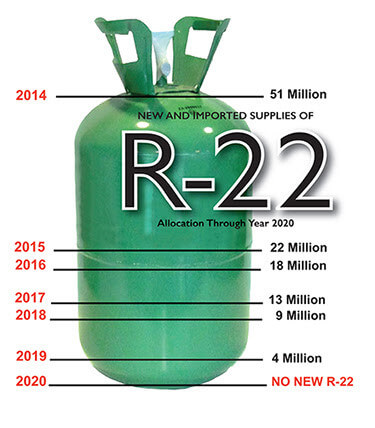R-22 Phase-Out: What It Means for You?
United States EPA
Final Rule Phase Out of R-22
In recent years, the EPA has been phasing out R-22. R-22 is a refrigerant used in older HVAC units to help keep indoor temperatures cooler. As the temperatures get warmer during these hot and long summers, your AC gets used more and more. This places a huge burden on your system resulting in potentially costly repairs and maintenance.
In the past, a simple solution was to pump more R-22 into an HVAC system. Chances are that if your AC unit is 5 or more years old, it may use R-22. However with the phase-out of R-22, supplies of the refrigerant are getting restricted and homeowners need to think twice before applying this simple recharge fix.
Reasons for Restrictions
R-22 is a refrigerant that is a CFC or chlorofluorocarbon. It is well known that CFCs can react with chemicals and cause damage to the ozone layer. By enacting a phase-out, the EPA hopes to reduce reliance on R-22 and encourage use of more eco-friendly chemicals.
One reason the EPA created restrictions on R-22 was to make the price go up. This makes consumers think long and hard about alternatives instead of performing a simple recharge with R-22. Some alternatives include purchasing more efficient systems that use eco-friendly chemicals.
Another reason is to encourage homeowners to have their HVAC professional fix leaks instead of pumping more R-22. Fewer leaks reduces R-22 consumption and could potentially save money especially when the price of R-22 is so high.
New Systems
The EPA started placing supply restrictions on R-22 back in 2010 by setting limits on production and imports. Since then, the prices of the refrigerant have doubled and tripled forcing consumers to consider new systems.
Though the new systems may be more expensive, they have distinct advantages over the older units.
One advantage of newer systems is efficiency. New systems use less energy as a result of internal components that maximize heat exchange. Since less energy is used, consumers may realize cost savings that exceed the cost of maintaining and operating the old systems.
Another advantage is the use of eco-friendly chemicals. Instead of R-22, newer systems use R-410A. It is a HCFC or hydrochlorofluorocarbon which does not contribute to ozone depletion.
Since the new systems use a different refrigerant, you may wondering if it could be used on the old systems. Unfortunately, the older systems have different components and pressure settings that will not be able to handle the R-410A. It is also not possible to use a newer condenser with an existing air handler since both must use the same refrigerant.
Conclusion
Getting your HVAC unit through the summer may not be as simple as an R-22 recharge fix. The EPA, in an effort to curb ozone depleting chemicals, has restricted supplies of R-22. Consequently, a simple, cheap fix in the past is now more expensive than ever. Instead, replacement with newer systems may save you money in the long run.
Need help deciding? Get in touch with our HVAC professionals today to help you decide what’s best for you and your family!

